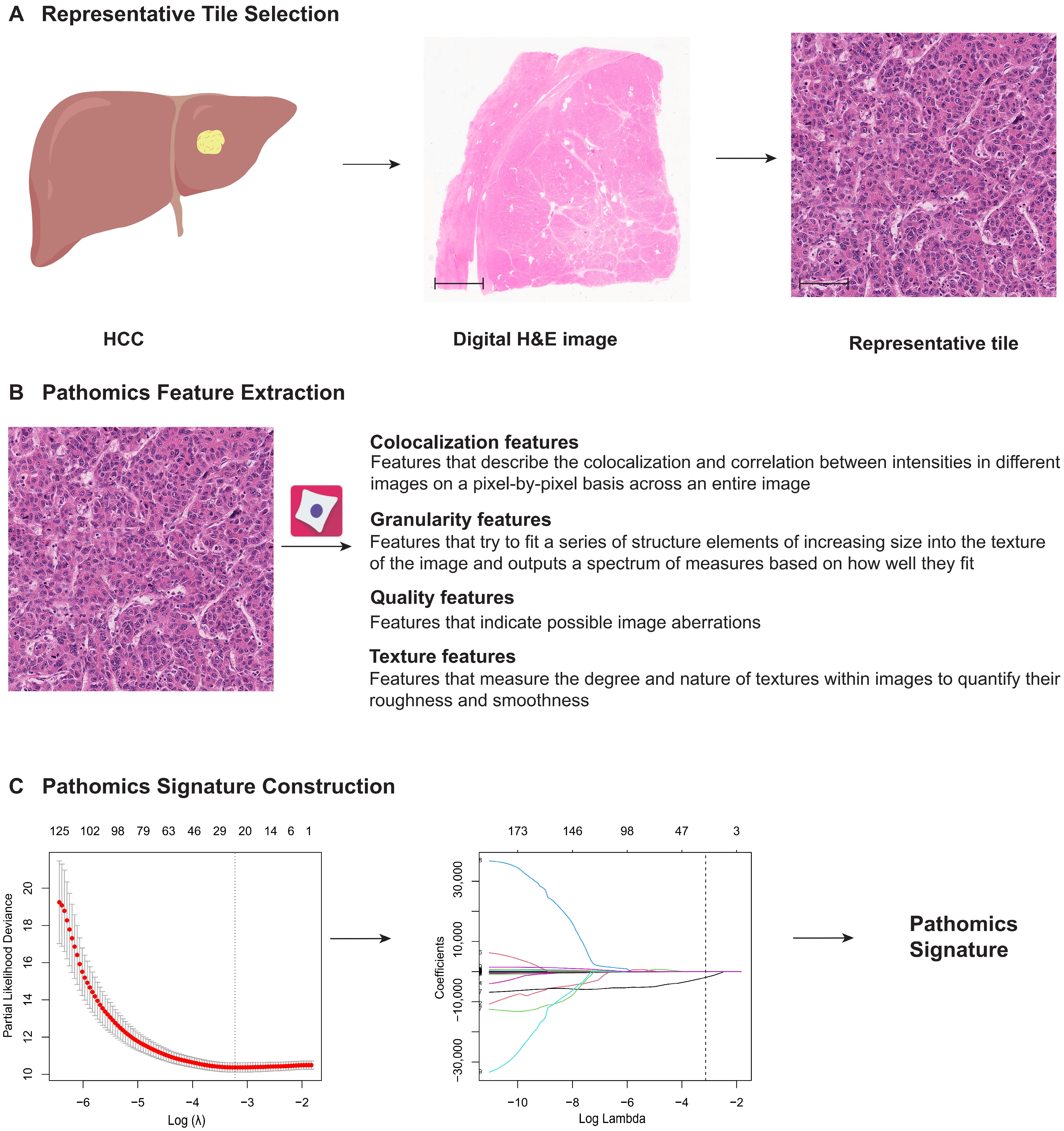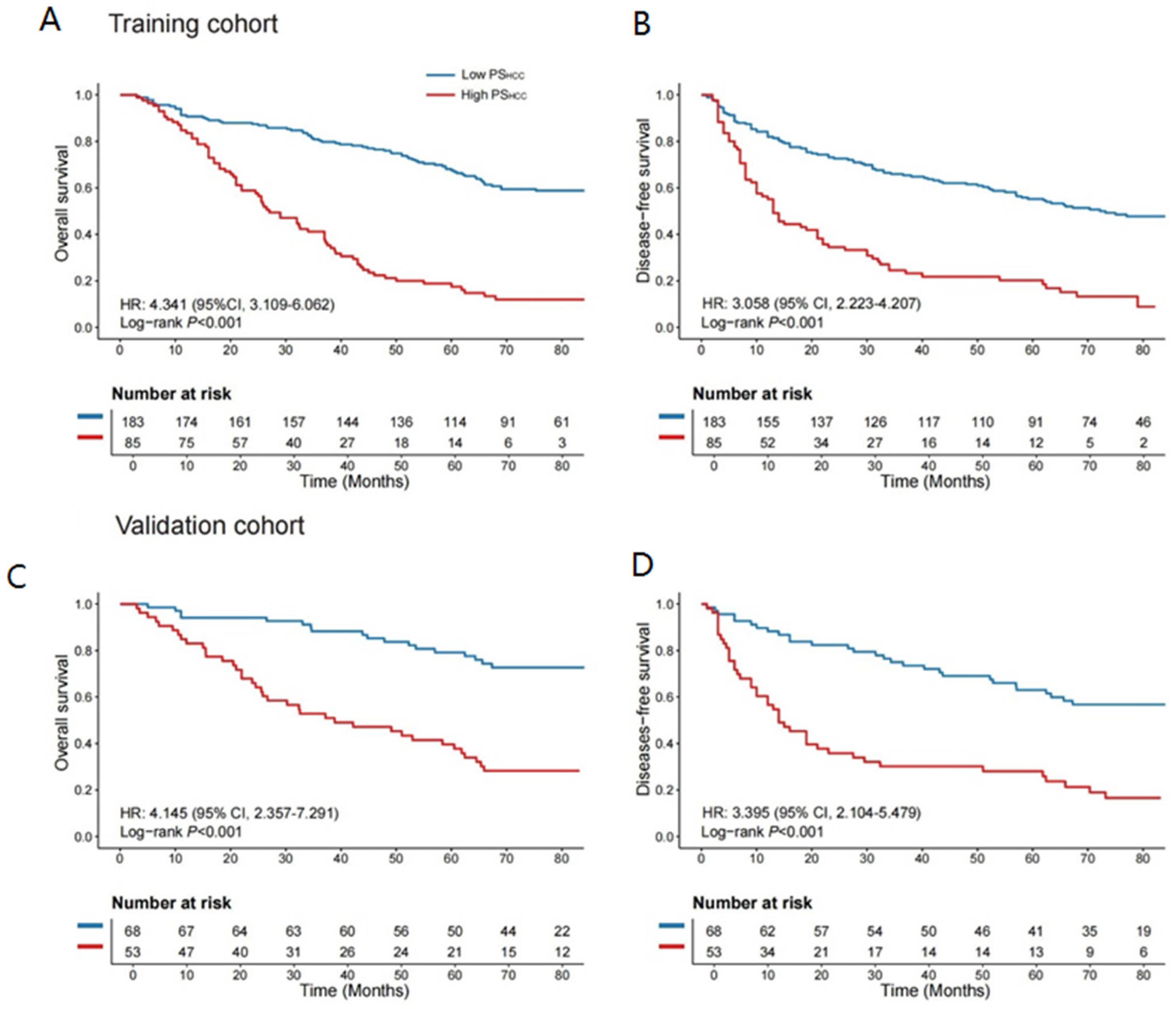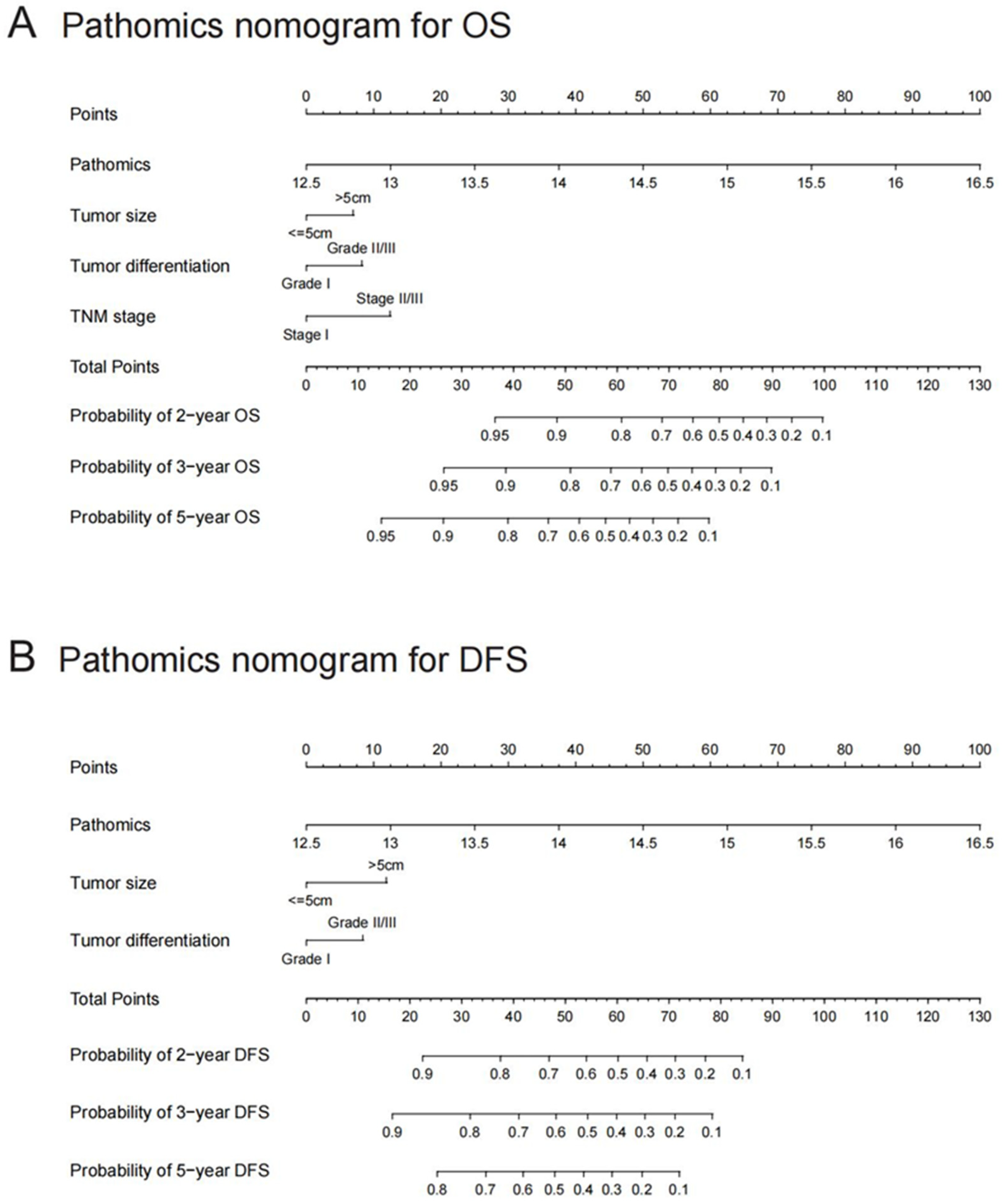Use of a Pathomics Signature to Predict the Prognosis of Hepatocellular Carcinoma with Cirrhosis: A Multicentre Retrospective Study
Simple Summary
Abstract
1. Introduction
2. Materials and Methods
2.1. Study Design
2.2. Participants
2.3. Sample Preparation and Region of Interest Selection
2.4. Pathomics Feature Extraction
2.5. PSHCC Construction
2.6. Prognostic Value of the PSHCC
2.7. Development and Validation of the Pathomics Nomogram for Prognosis
2.8. Incremental Value of the PSHCC for Prognosis Prediction
2.9. Statistical Analysis
3. Results
3.1. Patient Characteristics
3.2. Construction of the PSHCC
3.3. Association of the PSHCC with Prognosis
3.4. Construction and Validation of the Pathomics Nomograms
3.5. Comparison Between the Pathomics Nomograms and Traditional Models
4. Discussion
5. Conclusions
Supplementary Materials
Author Contributions
Funding
Institutional Review Board Statement
Informed Consent Statement
Data Availability Statement
Conflicts of Interest
Abbreviations
| HCC | Hepatocellular carcinoma |
| PSHCC | Pathomics signature of HCC |
| OS | Overall survival |
| DFS | Disease-free survival |
| HR | Hazard ratio |
| CI | Confidential interval |
| BCLC | Barcelona Clinic Liver Cancer |
| HKLC | Hong Kong Liver Cancer |
| AJCC | American Joint Committee on Cancer |
| H&E | Hematoxylin and eosin |
| LASSO | Least absolute shrinkage and selection operator |
| DCA | Decision curve analysis |
| ROC | Receiver operating characteristic |
| AUROC | Area under the receiver operating characteristic curve |
| NCCN | National Comprehensive Cancer Network |
| ALBI | Albumin–bilirubin |
References
- Sung, H.; Ferlay, J.; Siegel, R.L.; Laversanne, M.; Soerjomataram, I.; Jemal, A.; Bray, F. Global cancer statistics 2022: GLOBOCAN estimates of incidence and mortality worldwide for 36 cancers in 185 countries. CA Cancer J. Clin. 2024, 74, 229–263. [Google Scholar] [CrossRef]
- Villanueva, A. Hepatocellular Carcinoma. N. Engl. J. Med. 2019, 380, 1450–1462. [Google Scholar] [CrossRef]
- European Association for the Study of the Liver. EASL Clinical Practice Guidelines: Management of hepatocellular carcinoma. J. Hepatol. 2018, 69, 182–236. [Google Scholar] [CrossRef]
- Vogel, A.; Cervantes, A.; Chau, I.; Daniele, B.; Llovet, J.M.; Meyer, T.; Nault, J.C.; Neumann, U.; Ricke, J.; Sangro, B.; et al. Hepatocellular carcinoma: ESMO Clinical Practice Guidelines for diagnosis, treatment and follow-up. Ann. Oncol. 2018, 29, iv238–iv255. [Google Scholar] [CrossRef]
- Chen, E.; He, Y.; Jiang, J.; Yi, J.; Zou, Z.; Song, Q.; Ren, Q.; Lin, Z.; Lu, Y.; Liu, J.; et al. CDCA8 induced by NF-YA promotes hepatocellular carcinoma progression by regulating the MEK/ERK pathway. Exp. Hematol. Oncol. 2023, 12, 9. [Google Scholar] [CrossRef] [PubMed]
- Llovet, J.M.; Kelley, R.K.; Villanueva, A.; Singal, A.G.; Pikarsky, E.; Roayaie, S.; Lencioni, R.; Koike, K.; Zucman-Rossi, J.; Finn, R.S. Hepatocellular carcinoma. Nat. Rev. Dis. Primers 2021, 7, 6. [Google Scholar] [CrossRef] [PubMed]
- Sasaki, K.; Shindoh, J.; Margonis, G.A.; Nishioka, Y.; Andreatos, N.; Sekine, A.; Hashimoto, M.; Pawlik, T.M. Effect of Background Liver Cirrhosis on Outcomes of Hepatectomy for Hepatocellular Carcinoma. JAMA Surg. 2017, 152, e165059. [Google Scholar] [CrossRef] [PubMed]
- Shen, X.T.; Xie, S.Z.; Zheng, X.; Zou, T.T.; Hu, B.Y.; Xu, J.; Liu, L.; Xu, Y.F.; Wang, X.F.; Wang, H.; et al. Cirrhotic-extracellular matrix attenuates aPD-1 treatment response by initiating immunosuppressive neutrophil extracellular traps formation in hepatocellular carcinoma. Exp. Hematol. Oncol. 2024, 13, 20. [Google Scholar] [CrossRef]
- Baxi, V.; Edwards, R.; Montalto, M.; Saha, S. Digital pathology and artificial intelligence in translational medicine and clinical practice. Mod. Pathol. 2022, 35, 23–32. [Google Scholar] [CrossRef]
- Rashid, R.; Chen, Y.A.; Hoffer, J.; Muhlich, J.L.; Lin, J.R.; Krueger, R.; Pfister, H.; Mitchell, R.; Santagata, S.; Sorger, P.K. Narrative online guides for the interpretation of digital-pathology images and tissue-atlas data. Nat. Biomed. Eng. 2022, 6, 515–526. [Google Scholar] [CrossRef]
- Jiang, Y.; Yang, M.; Wang, S.; Li, X.; Sun, Y. Emerging role of deep learning-based artificial intelligence in tumor pathology. Cancer Commun. 2020, 40, 154–166. [Google Scholar] [CrossRef] [PubMed]
- Bera, K.; Schalper, K.A.; Rimm, D.L.; Velcheti, V.; Madabhushi, A. Artificial intelligence in digital pathology—New tools for diagnosis and precision oncology. Nat. Rev. Clin. Oncol. 2019, 16, 703–715. [Google Scholar] [CrossRef] [PubMed]
- Niazi, M.K.K.; Parwani, A.V.; Gurcan, M.N. Digital pathology and artificial intelligence. Lancet Oncol. 2019, 20, e253–e261. [Google Scholar] [CrossRef] [PubMed]
- Zhang, Y.; Yang, Z.; Chen, R.; Zhu, Y.; Liu, L.; Dong, J.; Zhang, Z.; Sun, X.; Ying, J.; Lin, D.; et al. Histopathology images-based deep learning prediction of prognosis and therapeutic response in small cell lung cancer. NPJ Digit. Med. 2024, 7, 15. [Google Scholar] [CrossRef]
- Chen, S.; Jiang, L.; Zheng, X.; Shao, J.; Wang, T.; Zhang, E.; Gao, F.; Wang, X.; Zheng, J. Clinical use of machine learning-based pathomics signature for diagnosis and survival prediction of bladder cancer. Cancer Sci. 2021, 112, 2905–2914. [Google Scholar] [CrossRef]
- Chen, S.; Jiang, L.; Gao, F.; Zhang, E.; Wang, T.; Zhang, N.; Wang, X.; Zheng, J. Machine learning-based pathomics signature could act as a novel prognostic marker for patients with clear cell renal cell carcinoma. Br. J. Cancer 2022, 126, 771–777. [Google Scholar] [CrossRef]
- Chen, D.; Fu, M.; Chi, L.; Lin, L.; Cheng, J.; Xue, W.; Long, C.; Jiang, W.; Dong, X.; Sui, J.; et al. Prognostic and predictive value of a pathomics signature in gastric cancer. Nat. Commun. 2022, 13, 6903. [Google Scholar] [CrossRef]
- Jiang, W.; Wang, H.; Dong, X.; Yu, X.; Zhao, Y.; Chen, D.; Yan, B.; Cheng, J.; Zhuo, S.; Wang, H.; et al. Pathomics Signature for Prognosis and Chemotherapy Benefits in Stage III Colon Cancer. JAMA Surg. 2024, 159, 519–528. [Google Scholar] [CrossRef]
- Jiang, Y.; Zhang, Q.; Hu, Y.; Li, T.; Yu, J.; Zhao, L.; Ye, G.; Deng, H.; Mou, T.; Cai, S.; et al. ImmunoScore Signature: A Prognostic and Predictive Tool in Gastric Cancer. Ann. Surg. 2018, 267, 504–513. [Google Scholar] [CrossRef]
- Chen, D.; Chen, H.; Chi, L.; Fu, M.; Wang, G.; Wu, Z.; Xu, S.; Sun, C.; Xu, X.; Lin, L.; et al. Association of Tumor-Associated Collagen Signature with Prognosis and Adjuvant Chemotherapy Benefits in Patients with Gastric Cancer. JAMA Netw. Open. 2021, 4, e2136388. [Google Scholar] [CrossRef]
- Ranstam, J.; Cook, J.A. LASSO regression. Br. J. Surg. 2018, 105, 1348. [Google Scholar] [CrossRef]
- Tibshirani, R. The lasso method for variable selection in the Cox model. Stat. Med. 1997, 16, 385–395. [Google Scholar] [CrossRef]
- Chen, E.; Zou, Z.; Wang, R.; Liu, J.; Peng, Z.; Gan, Z.; Lin, Z.; Liu, J. Predictive value of a stemness-based classifier for prognosis and immunotherapy response of hepatocellular carcinoma based on bioinformatics and machine-learning strategies. Front. Immunol. 2024, 15, 1244392. [Google Scholar] [CrossRef] [PubMed]
- McQuin, C.; Goodman, A.; Chernyshev, V.; Kamentsky, L.; Cimini, B.A.; Karhohs, K.W.; Doan, M.; Ding, L.; Rafelski, S.M.; Thirstrup, D.; et al. CellProfiler 3.0: Next-generation image processing for biology. PLoS Biol. 2018, 16, e2005970. [Google Scholar] [CrossRef]
- He, Y.; Zou, Z.; Lan, Z.; Chang, M.; Zhang, X.; Lin, R.; Zhang, W.; Zhang, G.; Wang, T.; Chen, E. Prognostic implication of six m6A-modulated genes signature in the ferroptosis for hepatocellular carcinoma patients. Clin. Exp. Med. 2025, 25, 180. [Google Scholar] [CrossRef]
- Gao, D.; Li, S.; Guo, H.; Liu, X.; Liu, Z.; Li, L.; Bao, L.; Dang, X. A Predictive Model Based on the FBXO Family Reveals the Significance of Cyclin F in Hepatocellular Carcinoma. Front. Biosci. 2024, 29, 202. [Google Scholar] [CrossRef]
- Wang, F.; Zhan, G.; Chen, Q.Q.; Xu, H.Y.; Cao, D.; Zhang, Y.Y.; Li, Y.H.; Zhang, C.J.; Jin, Y.; Ji, W.B.; et al. Multitask deep learning for prediction of microvascular invasion and recurrence-free survival in hepatocellular carcinoma based on MRI images. Liver Int. 2024, 44, 1351–1362. [Google Scholar] [CrossRef]
- Ji, G.W.; Zhu, F.P.; Xu, Q.; Wang, K.; Wu, M.Y.; Tang, W.W.; Li, X.C.; Wang, X.H. Radiomic Features at Contrast-enhanced CT Predict Recurrence in Early Stage Hepatocellular Carcinoma: A Multi-Institutional Study. Radiology 2020, 294, 568–579. [Google Scholar] [CrossRef]
- Xu, X.; Zhang, H.L.; Liu, Q.P.; Sun, S.W.; Zhang, J.; Zhu, F.P.; Yang, G.; Yan, X.; Zhang, Y.D.; Liu, X.S. Radiomic analysis of contrast-enhanced CT predicts microvascular invasion and outcome in hepatocellular carcinoma. J. Hepatol. 2019, 70, 1133–1144. [Google Scholar] [CrossRef]
- Wang, R.; Dai, W.; Gong, J.; Huang, M.; Hu, T.; Li, H.; Lin, K.; Tan, C.; Hu, H.; Tong, T.; et al. Development of a novel combined nomogram model integrating deep learning-pathomics, radiomics and immunoscore to predict postoperative outcome of colorectal cancer lung metastasis patients. J. Hematol. Oncol. 2022, 15, 11. [Google Scholar] [CrossRef]
- Huang, K.B.; Gui, C.P.; Xu, Y.Z.; Li, X.S.; Zhao, H.W.; Cao, J.Z.; Chen, Y.H.; Pan, Y.H.; Liao, B.; Cao, Y.; et al. A multi-classifier system integrated by clinico-histology-genomic analysis for predicting recurrence of papillary renal cell carcinoma. Nat. Commun. 2024, 15, 6215. [Google Scholar] [CrossRef]
- Qu, W.F.; Tian, M.X.; Lu, H.W.; Zhou, Y.F.; Liu, W.R.; Tang, Z.; Yao, Z.; Huang, R.; Zhu, G.Q.; Jiang, X.F.; et al. Development of a deep pathomics score for predicting hepatocellular carcinoma recurrence after liver transplantation. Hepatol. Int. 2023, 17, 927–941. [Google Scholar] [CrossRef]
- Liu, Z.; Liu, Y.; Zhang, W.; Hong, Y.; Meng, J.; Wang, J.; Zheng, S.; Xu, X. Deep learning for prediction of hepatocellular carcinoma recurrence after resection or liver transplantation: A discovery and validation study. Hepatol. Int. 2022, 16, 577–589. [Google Scholar] [CrossRef]
- Bankhead, P. Developing image analysis methods for digital pathology. J. Pathol. 2022, 257, 391–402. [Google Scholar] [CrossRef] [PubMed]
- Carpenter, A.E.; Kamentsky, L.; Eliceiri, K.W. A call for bioimaging software usability. Nat. Methods 2012, 9, 666–670. [Google Scholar] [CrossRef] [PubMed]
- Rudin, C. Stop Explaining Black Box Machine Learning Models for High Stakes Decisions and Use Interpretable Models Instead. Nat. Mach. Intell. 2019, 1, 206–215. [Google Scholar] [CrossRef] [PubMed]
- Madabhushi, A.; Lee, G. Image analysis and machine learning in digital pathology: Challenges and opportunities. Med. Image Anal. 2016, 33, 170–175. [Google Scholar] [CrossRef]
- National Comprehensive Cancer Network. NCCN Clinical Practice Guidelines in Oncology (NCCN Guidelines®) Hepatocellular Carcinoma. Version 4.2024. Available online: https://www.nccn.org/professionals/physician_gls/pdf/hcc.pdf (accessed on 12 March 2025).
- Hiraoka, A.; Kumada, T.; Michitaka, K.; Kudo, M. Newly Proposed ALBI Grade and ALBI-T Score as Tools for Assessment of Hepatic Function and Prognosis in Hepatocellular Carcinoma Patients. Liver Cancer 2019, 8, 312–325. [Google Scholar] [CrossRef]
- Tadokoro, T.; Kobayashi, T.; Honmyo, N.; Kuroda, S.; Ohira, M.; Hashimoto, M.; Oishi, K.; Oshita, A.; Abe, T.; Onoe, T.; et al. Albumin-Butyrylcholinesterase as a Novel Prognostic Biomarker for Hepatocellular Carcinoma Post-hepatectomy: A Retrospective Cohort Study with the Hiroshima Surgical Study Group of Clinical Oncology. Ann. Surg. Oncol. 2025, 32, 1973–1984. [Google Scholar] [CrossRef]
- Akabane, M.; Kawashima, J.; Altaf, A.; Woldesenbet, S.; Cauchy, F.; Aucejo, F.; Popescu, I.; Kitago, M.; Martel, G.; Ratti, F.; et al. Enhancing Recurrence-Free Survival Prediction in Hepatocellular Carcinoma: A Time-Updated Model Incorporating Tumor Burden and AFP Dynamics. Ann. Surg. Oncol. 2025, 32, 5648–5656. [Google Scholar] [CrossRef]
- Xu, X.F.; Wu, H.; Gu, L.H.; Zhao, Y.Z.; Zhou, Y.H.; Chen, T.H.; Guo, H.W.; Chen, Z.; Lin, K.Y.; Gu, W.M.; et al. Development and Validation of an Individualized Prediction Model for Postoperative Late Recurrence After Hepatectomy for Hepatocellular Carcinoma (POLAR-HCC): A Multicenter Study. Ann. Surg. Oncol. 2025; Epub ahead of print. [Google Scholar] [CrossRef]
- Berhane, S.; Fox, R.; García-Fiñana, M.; Cucchetti, A.; Johnson, P. Using prognostic and predictive clinical features to make personalised survival prediction in advanced hepatocellular carcinoma patients undergoing sorafenib treatment. Br. J. Cancer 2019, 121, 117–124. [Google Scholar] [CrossRef]
- Xie, Q.; Zhao, Z.; Yang, Y.; Wang, X.; Wu, W.; Jiang, H.; Hao, W.; Peng, R.; Luo, C. A clinical-radiomic-pathomic model for prognosis prediction in patients with hepatocellular carcinoma after radical resection. Cancer Med. 2024, 13, e7374. [Google Scholar] [CrossRef]
- Feng, L.; Huang, W.; Pan, X.; Ruan, F.; Li, X.; Tan, S.; Long, L. Predicting overall survival in hepatocellular carcinoma patients via a combined MRI radiomics and pathomics signature. Transl. Oncol. 2025, 51, 102174. [Google Scholar] [CrossRef]




| Characteristics | Patients, No. (%) | Patients, No. (%) | p |
|---|---|---|---|
| Training Cohort (n = 268) | Validation Cohort (n = 121) | ||
| Age, year | 0.282 | ||
| ≤50 | 111 (41.4) | 44 (36.4) | |
| >50 | 157 (58.6) | 77 (63.6) | |
| Sex | 0.406 | ||
| Female | 30 (11.2) | 19 (15.7) | |
| Male | 238 (88.8) | 102 (84.3) | |
| Etiology of liver diseases | 0.546 | ||
| HBV | 234 (87.3) | 104 (86.0) | |
| HCV | 21 (7.8) | 10 (8.3) | |
| None or other | 13 (4.9) | 7 (5.7) | |
| HBV | 0.836 | ||
| Absent | 34 (12.7) | 17 (14.0) | |
| Present | 234 (87.3) | 104 (86.0) | |
| Child–Pugh grade | |||
| A | 258 (96.3) | 115 (95.0) | 0.587 |
| B | 10 (3.7) | 6 (5.0) | |
| AFP 1 | 0.567 | ||
| Normal | 105 (39.2) | 44 (36.4) | |
| Elevated | 163 (60.8) | 77 (63.6) | |
| Tumor size | 0.174 | ||
| ≤5 cm | 163 (60.8) | 83 (68.6) | |
| >5 cm | 105 (39.2) | 38 (31.4) | |
| Tumor number | 0.050 | ||
| Single | 216 (80.6) | 108 (89.3) | |
| Multiple | 52 (19.4) | 13 (10.7) | |
| Tumor encapsulation | 0.563 | ||
| Yes | 154 (57.5) | 65 (53.7) | |
| No | 114 (42.5) | 56 (46.3) | |
| Vascular invasion | 0.266 | ||
| No | 162 (60.4) | 81 (66.9) | |
| Yes | 106 (39.6) | 40 (33.1) | |
| Tumor differentiation | |||
| Grage I | 193 (72.0) | 92 (76.0) | 0.481 |
| Grade II-III | 75 (28.0) | 29 (24.0) | |
| TNM stage | 0.053 | ||
| Stage I | 134 (50.0) | 74 (61.2) | |
| Stage II-III | 134 (50.0) | 47 (38.8) |
| Variables | Univariate Analysis | p | Multivariable Analysis | p |
|---|---|---|---|---|
| HR (95%CI) | HR (95%CI) | |||
| Overall survival | ||||
| Age | 0.897 (0.647–1.244) | 0.516 | ||
| Sex (Female vs. Male) | 0.987 (0.587–1.658) | 0.961 | ||
| HBV (Absent vs. Present) | 1.227 (0.730–2.063) | 0.439 | ||
| Child–Pugh grade (A vs. B) | 1.267 (0.560–2.87) | 0.571 | ||
| Preoperative AFP level (Normal vs. Elevated) | 1.529 (1.089–2.148) | 0.014 | ||
| Tumor size (≤ 5 cm vs. > 5 cm) | 1.815 (1.314–2.508) | <0.001 | 1.649 (1.170–2.323) | 0.004 |
| Tumor number (Single vs. Multiple) | 2.495 (1.743–3.570) | <0.001 | ||
| Tumor differentiation (Grade I vs. Grade II–III) | 1.972 (1.411–2.756) | <0.001 | 1.769 (1.250–2.502) | 0.001 |
| Tumor encapsulation (Yes vs. No) | 1.091 (0.788–1.510) | 0.601 | ||
| Vascular invasion (No vs. Yes) | 1.785 (1.291–2.467) | <0.001 | ||
| AJCC TNM stage (Stage I vs. Stage II-III) | 2.773 (1.977–3.889) | <0.001 | 2.292 (1.243–4.228) | 0.008 |
| PSHCC | 5.351 (3.766–7.605) | <0.001 | 4.368 (3.083–6.188) | <0.001 |
| Disease-free survival | ||||
| Age | 1.017 (0.744–1.389) | 0.335 | ||
| Sex (Female vs. Male) | 1.299 (0.764–1.389) | 0.918 | ||
| HBV (Absent vs. Present) | 1.188 (0.728–1.940) | 0.491 | ||
| Child–Pugh grade (A vs. B) | 1.074 (0.475–2.428) | 0.864 | ||
| Preoperative AFP level (Normal vs. Elevated) | 1.559 (1.129–2.154) | 0.007 | ||
| Tumor size (≤5 cm vs. >5 cm) | 1.775 (1.305–2.416) | <0.001 | 1.691 (1.216–2.351) | 0.002 |
| Tumor number (Single vs. Multiple) | 2.299 (1.618–3.268) | <0.001 | ||
| Tumor differentiation (Grade I vs. Grade II–III) | 1.716 (1.238–2.377) | 0.001 | 1.548 (1.106–2.166) | 0.011 |
| Tumor encapsulation (Yes vs. No) | 1.224 (0.899–1.664) | 0.198 | ||
| Vascular invasion (No vs. Yes) | 1.667 (1.224–2.268) | 0.001 | ||
| TNM stage (Stage I vs. Stage II–III) | 2.229 (1.627–3.053) | <0.001 | ||
| PSHCC | 3.565 (2.548–4.988) | <0.001 | 2.926 (2.080–4.117) | <0.001 |
Disclaimer/Publisher’s Note: The statements, opinions and data contained in all publications are solely those of the individual author(s) and contributor(s) and not of MDPI and/or the editor(s). MDPI and/or the editor(s) disclaim responsibility for any injury to people or property resulting from any ideas, methods, instructions or products referred to in the content. |
© 2025 by the authors. Licensee MDPI, Basel, Switzerland. This article is an open access article distributed under the terms and conditions of the Creative Commons Attribution (CC BY) license (https://creativecommons.org/licenses/by/4.0/).
Share and Cite
Wang, T.; Zheng, J.; Guo, L.; Fan, J.; Lu, Y.; Peng, Z.; Zhong, Y.; Zhou, Z.; Chen, E. Use of a Pathomics Signature to Predict the Prognosis of Hepatocellular Carcinoma with Cirrhosis: A Multicentre Retrospective Study. Cancers 2025, 17, 3192. https://doi.org/10.3390/cancers17193192
Wang T, Zheng J, Guo L, Fan J, Lu Y, Peng Z, Zhong Y, Zhou Z, Chen E. Use of a Pathomics Signature to Predict the Prognosis of Hepatocellular Carcinoma with Cirrhosis: A Multicentre Retrospective Study. Cancers. 2025; 17(19):3192. https://doi.org/10.3390/cancers17193192
Chicago/Turabian StyleWang, Ting, Jixiang Zheng, Lingling Guo, Jiawen Fan, Yubin Lu, Zhen Peng, Yanfeng Zhong, Zhengjun Zhou, and Erbao Chen. 2025. "Use of a Pathomics Signature to Predict the Prognosis of Hepatocellular Carcinoma with Cirrhosis: A Multicentre Retrospective Study" Cancers 17, no. 19: 3192. https://doi.org/10.3390/cancers17193192
APA StyleWang, T., Zheng, J., Guo, L., Fan, J., Lu, Y., Peng, Z., Zhong, Y., Zhou, Z., & Chen, E. (2025). Use of a Pathomics Signature to Predict the Prognosis of Hepatocellular Carcinoma with Cirrhosis: A Multicentre Retrospective Study. Cancers, 17(19), 3192. https://doi.org/10.3390/cancers17193192






